Lecture Materials
Polynomials and their roots#
Polynomials play an important role in numerical analysis and computational physics. According to the Fundamental Theorem of Algebra, every non-constant polynomial has at least one root. Many special polynomials are used in numerical analysis, such as Legendre polynomials, Chebyshev polynomials, and Laguerre polynomials which have \(n\) real roots.
The methods we learned so far can be used to find only one root at a time. Let us explore some methods that can find all roots of a polynomial.
Polynomial#
Polynomial \(P(x)\) of order \(n\) has a general expression
For calculations we write it in a form
This allows one to define iterative procedure for calculation of \(P(x)\) as well as its derivative \(P'(x)\)
# Evaluate the polynomial with coefficients a
# at a point x
def Poly(x,a):
ret = a[len(a) - 1]
for j in range(len(a) - 2, -1, -1):
ret = ret * x + a[j]
return ret
# Evaluate the derivative of a polynomial
# with coefficients a at a point x
def dPoly(x,a):
p = a[len(a) - 1]
dp = 0.
for j in range(len(a) - 2, -1, -1):
dp = dp * x + p
p = p * x + a[j]
return dp
Multiplication and division#
Let us multiply \(P(x)\) by \((x-c)\). The result is a polynomial \(\tilde{P}(x)\) of order \(n+1\):
The coefficients \(\tilde{a}_j(x)\) can be readily expressed in terms of \(a_j(x)\):
and
These relations can also be inverted to express coefficients \(a_j\) of \(P(x) = \tilde{P(x)} / (x-c)\) in terms of \(\tilde{a}_j\) defining the division of a polynomial (deflation):
with \(a_{n+1} = 0\).
Of course, the deflation (division) by \((x-c)\) presented here only makes sense if \(x=c\) is a root of \(P(x)\).
# Multiply polynomial by (x - c)
def PolyMult(a,c):
n = len(a)
ret = a[:]
ret.append(ret[-1])
for j in range(n-1,0,-1):
ret[j] = ret[j-1] - c * ret[j]
ret[0] = -c * ret[0]
return ret
# Divide the polynomial by (x - c),
# assuming x = c is one of the roots
def PolyDiv(a,c):
n = len(a) - 1
ret = a[:]
ret[-1] = 0.
for j in range(n-1,-1,-1):
ret[j] = a[j+1] + c * ret[j+1]
ret.pop()
return ret
Example: Legendre polynomials#
Let us now consider a specific example of a polynomial, namely the 6th order Legendre polynomial \(P_6(x)\):
coefficients_Legendre6 = [-5./16., 0.,
105./16., 0.,
-315./16., 0.,
231./16.]
def fP6(x):
return Poly(x,coefficients_Legendre6)
def dfP6(x):
return dPoly(x,coefficients_Legendre6)
xplot = np.linspace(-1,1,100)
plt.xlabel("${x}$")
plt.ylabel('${P_6(x)}$')
plt.plot(xplot,fP6(xplot),label = '${y_1}')
plt.axhline(y = 0., color = 'black', linestyle = '--')
#plt.plot([1.841406], [0], 'ro')
plt.show()
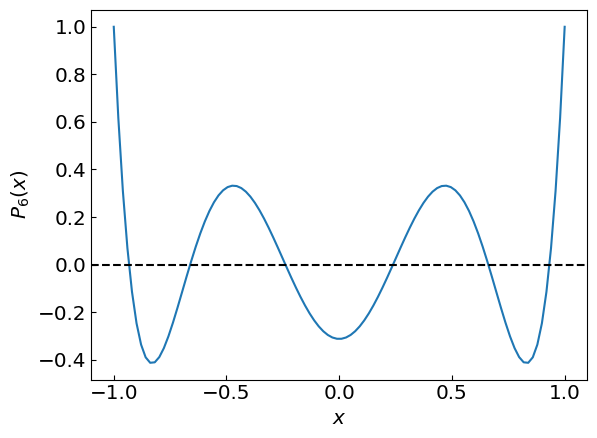
Let us use \(P_6(x)\) to test polynomial multiplication and deflation
coef1 = coefficients_Legendre6
iters = 5
xc = 0.7
print("Coefficients before multiplication:", coef1)
for i in range(0,iters):
coef1 = PolyMult(coef1,xc)
print(" Coefficients after multiplication:", coef1)
for i in range(0,iters):
coef1 = PolyDiv(coef1,xc)
print(" Coefficients after division:", coef1)
Coefficients before multiplication: [-0.3125, 0.0, 6.5625, 0.0, -19.6875, 0.0, 14.4375]
Coefficients after multiplication: [0.05252187499999998, -0.37515624999999997, -0.031084374999999775, 6.347031249999998, -18.106746875, 8.208906250000002, 42.132864375, -72.57403125, 19.38562500000001, 51.05624999999999, -50.53125, 14.4375]
Coefficients after division: [-0.312499999999972, 2.6645352591003757e-14, 6.562500000000022, 1.4210854715202004e-14, -19.687499999999996, 0.0, 14.4375]
We recover the coefficients after multiplying and dividing the polynomial by same factor several times in a row, although this procedure introduces visible round-off error. One thus has to be mindful of the error accumulation
Roots of polynomials#
Roots of the Legendre polynomials play an important role, for instance, when applied to numerical integration (such as Gauss-Legendre quadratures).
Let us evaluate the roots using what we learned so far.
Visual inspection and bisection#
\(P_6(x)\) has six roots on the real axis. By plotting \(P_6(x)\) we can easily figure out the brackets for each root and use the bisection method to evaluate the roots to desired precision
xplot = np.linspace(-1,1,100)
plt.xlabel("${x}$")
plt.ylabel('${P_6(x)}$')
plt.plot(xplot,fP6(xplot),label = '${P_6(x)}$')
#plt.plot(xroots,[0. for k in range(0,6)], 'ro', label = 'roots')
plt.plot([-1.,-1.],[-0.05,0.05], color='red')
plt.plot([-0.75,-0.75],[-0.05,0.05], color='red')
plt.plot([-0.5,-0.5],[-0.05,0.05], color='red')
plt.plot([0.,0.],[-0.05,0.05], color='red')
plt.plot([0.5,0.5],[-0.05,0.05], color='red')
plt.plot([0.75,0.75],[-0.05,0.05], color='red')
plt.plot([1.,1.],[-0.05,0.05], color='red')
plt.axhline(y = 0., color = 'black', linestyle = '--')
plt.legend()
plt.show()
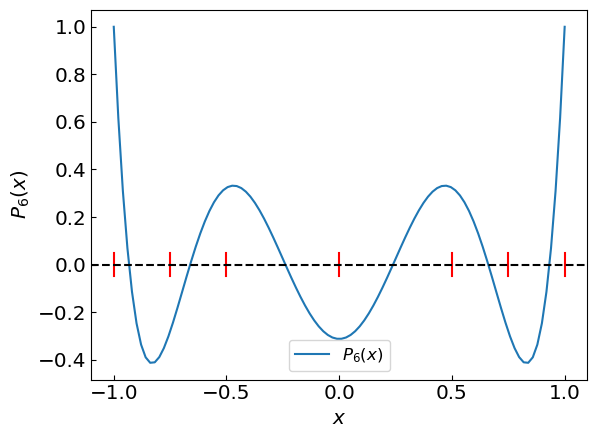
xroots = []
# Root 1
xleft = -1.
xright = -0.75
xroots.append(bisection_method(fP6,xleft,xright))
print("Root 1 between", xleft, "and", xright, "is x =",xroots[-1])
xleft = -0.75
xright = -0.5
xroots.append(bisection_method(fP6,xleft,xright))
print("Root 2 between", xleft, "and", xright, "is x =",xroots[-1])
xleft = -0.5
xright = 0.
xroots.append(bisection_method(fP6,xleft,xright))
print("Root 3 between", xleft, "and", xright, "is x =",xroots[-1])
xleft = 0.
xright = 0.5
xroots.append(bisection_method(fP6,xleft,xright))
print("Root 4 between", xleft, "and", xright, "is x =",xroots[-1])
xleft = 0.5
xright = 0.75
xroots.append(bisection_method(fP6,xleft,xright))
print("Root 5 between", xleft, "and", xright, "is x =",xroots[-1])
xleft = 0.75
xright = 1.
xroots.append(bisection_method(fP6,xleft,xright))
print("Root 6 between", xleft, "and", xright, "is x =",xroots[-1])
xplot = np.linspace(-1,1,100)
plt.xlabel("${x}$")
plt.ylabel('${P_6(x)}$')
plt.plot(xplot,fP6(xplot),label = '${P_6(x)}$')
plt.plot(xroots,[0. for k in range(0,6)], 'ro', label = 'roots')
plt.axhline(y = 0., color = 'black', linestyle = '--')
plt.legend()
plt.show()
Root 1 between -1.0 and -0.75 is x = -0.9324695142277051
Root 2 between -0.75 and -0.5 is x = -0.6612093864532653
Root 3 between -0.5 and 0.0 is x = -0.23861918607144617
Root 4 between 0.0 and 0.5 is x = 0.23861918607144617
Root 5 between 0.5 and 0.75 is x = 0.6612093864532653
Root 6 between 0.75 and 1.0 is x = 0.9324695142277051
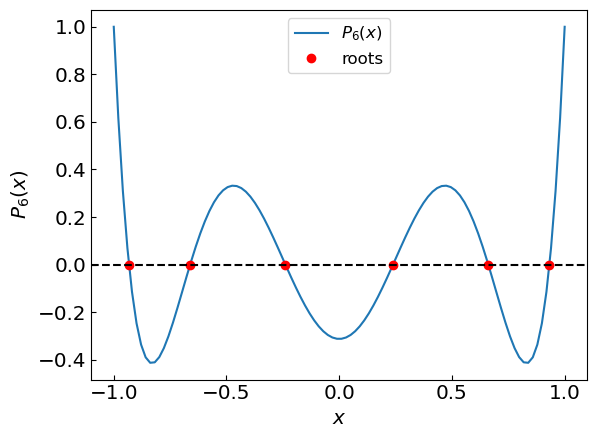
Newton-Raphson method using polynomial division#
Could we devise a procedure to find the roots without relying on manual inspection of the \(P_6(x)\) plot which would be easily generalizable to other polynomials?
One way to approach this problem is to use the Newton-Raphson method to find the roots of the polynomial \(P_6(x)\). If we start from some initial guess, we may expect the method to converge to the nearest root. The question is then how to find the other roots.
We can tackle this problem by applying polynomial division of \(P_6(x)\) by \((x - r)\) to find the quotient and then apply the Newton-Raphson method to the quotient to find the other roots.
The algorithm is as follows. For a polynomial \(P(x)\) with roots \(r_1, r_2, \ldots, r_n\):
Start with an initial guess \(r_0\).
Apply the Newton-Raphson method to find the root \(r_1\) of \(P(x)\).
Apply polynomial division of \(P(x)\) by \((x - r_1)\) to find the quotient \(Q(x)\).
Go back to step 2 and repeat the process until all roots are found.
It should be noted that the procedure is susceptible to the accumulation of round-off errors and may not converge to the correct roots. It may be a good idea to perform a refinement step after each root is found by applying the Newton-Raphson method to the original polynomial \(P(x)\) and using the determined roots as the initial guess.
The code for this algorithm is as follows:
def PolyRoots(
a, # The coefficients of the polynomial that we are solving
x0 = -1., # The initial guess for the first root
accuracy = 1.e-10, # The desired accuracy of the solution
polishing = True, # Whether to polish the roots further with Newton's method
max_iterations = 100 # Maximum number of iterations in Newton's method
):
ret = []
n = len(a)
apoly = a[:]
current_root = x0
def f(x):
return Poly(x,apoly)
def df(x):
return dPoly(x,apoly)
print("Searching all the roots using deflation and Newton's method")
# Loop over all the roots
for k in range(0,n-1,1):
current_root = newton_method(f,df,current_root,accuracy,max_iterations)
if (current_root == None):
print("Failed to find the next root!")
break
ret.append(current_root)
print("Root ", k+1, "is x = ",current_root)
# Deflate the polynomial
apoly = PolyDiv(apoly, current_root)
if polishing:
print("Polishing the roots by reapplying Newton's method to the original polynomial")
apoly = a[:]
for k in range(0,n-1,1):
ret[k] = newton_method(f,df,ret[k],accuracy,max_iterations)
print("Root ", k+1, "is x = ",ret[k])
return ret
Let us now apply the above algorithm to find the roots of the polynomial \(P_6(x)\).
x0 = -1.
newton_verbose = False
polishing = False
xroots = PolyRoots(coefficients_Legendre6, x0, accuracy, polishing)
print(xroots)
xplot = np.linspace(-1.,1.,100)
plt.xlabel("${x}$")
plt.ylabel('${P_6(x)}$')
plt.plot(xplot,fP6(xplot),label = '${P_6(x)}$')
plt.plot(xroots,[0. for k in range(0,len(xroots))], 'ro', label = 'roots')
plt.axhline(y = 0., color = 'black', linestyle = '--')
plt.legend()
plt.show()
Searching all the roots using deflation and Newton's method
Root 1 is x = -0.932469514203152
Root 2 is x = -0.6612093864662645
Root 3 is x = -0.23861918608319668
Root 4 is x = 0.23861918608319652
Root 5 is x = 0.6612093864662646
Root 6 is x = 0.9324695142031523
[-0.932469514203152, -0.6612093864662645, -0.23861918608319668, 0.23861918608319652, 0.6612093864662646, 0.9324695142031523]

Here is an animation of the deflation process and the successive root-finding:

Now we can straightforwardly calculate the roots of other polynomials
For example, \(P_9(x)\):
coefficients_Legendre9 = [
0., 315./128.,
0., -4620./128.,
0., 18018./128.,
0., -25740./128.,
0., 12155./128.]
x0 = -1.
newton_verbose = False
polishing = False
xroots = PolyRoots(coefficients_Legendre9, x0, accuracy, polishing)
xplot = np.linspace(-1.,1.,100)
plt.xlabel("${x}$")
plt.ylabel('${P_{9}(x)}$')
plt.plot(xplot,Poly(xplot,coefficients_Legendre9),label = '${P_{9}(x)}$')
plt.plot(xroots,[0. for k in range(0,len(xroots))], 'ro', label = 'roots')
plt.axhline(y = 0., color = 'black', linestyle = '--')
plt.legend()
plt.show()
Searching all the roots using deflation and Newton's method
Root 1 is x = -0.9681602395076263
Root 2 is x = -0.8360311073266355
Root 3 is x = -0.6133714327005905
Root 4 is x = -0.3242534234038087
Root 5 is x = -2.9050086835705924e-16
Root 6 is x = 0.32425342340380925
Root 7 is x = 0.6133714327005846
Root 8 is x = 0.8360311073266581
Root 9 is x = 0.968160239507609
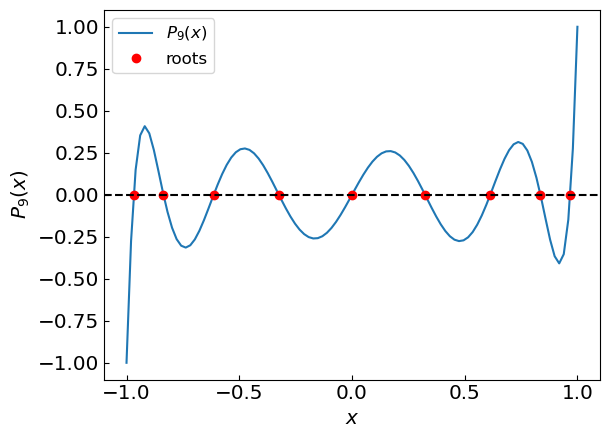
Another example is Hermite polynomials
coefficients_Hermite5 = [
0., 120.,
0., -160.,
0., 32.]
x0 = -2.
newton_verbose = False
polishing = True
xroots = PolyRoots(coefficients_Hermite5, x0, accuracy, polishing)
xplot = np.linspace(-2.5,2.5,100)
plt.xlabel("${x}$")
plt.ylabel('${H_{5}(x)}$')
plt.plot(xplot,Poly(xplot,coefficients_Hermite5),label = '${H_{5}(x)}$')
plt.plot(xroots,[0. for k in range(0,len(xroots))], 'ro', label = 'roots')
plt.axhline(y = 0., color = 'black', linestyle = '--')
plt.legend()
plt.show()
Searching all the roots using deflation and Newton's method
Root 1 is x = -2.0201828704560856
Root 2 is x = -0.9585724646138192
Root 3 is x = 1.0319700683878226e-15
Root 4 is x = 0.9585724646138175
Root 5 is x = 2.0201828704560865
Polishing the roots by reapplying Newton's method to the original polynomial
Root 1 is x = -2.0201828704560856
Root 2 is x = -0.9585724646138186
Root 3 is x = 0.0
Root 4 is x = 0.9585724646138185
Root 5 is x = 2.0201828704560856
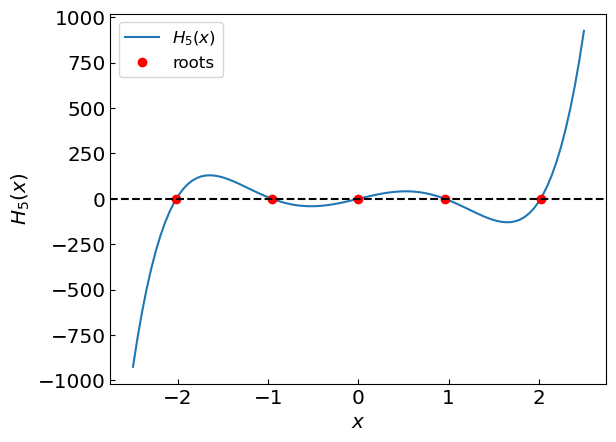
Further methods and reading#
Polynomial root finding as an eigenvalue problem
Chapter 9.5 of Numerical Recipes Third Edition by W.H. Press et al.

